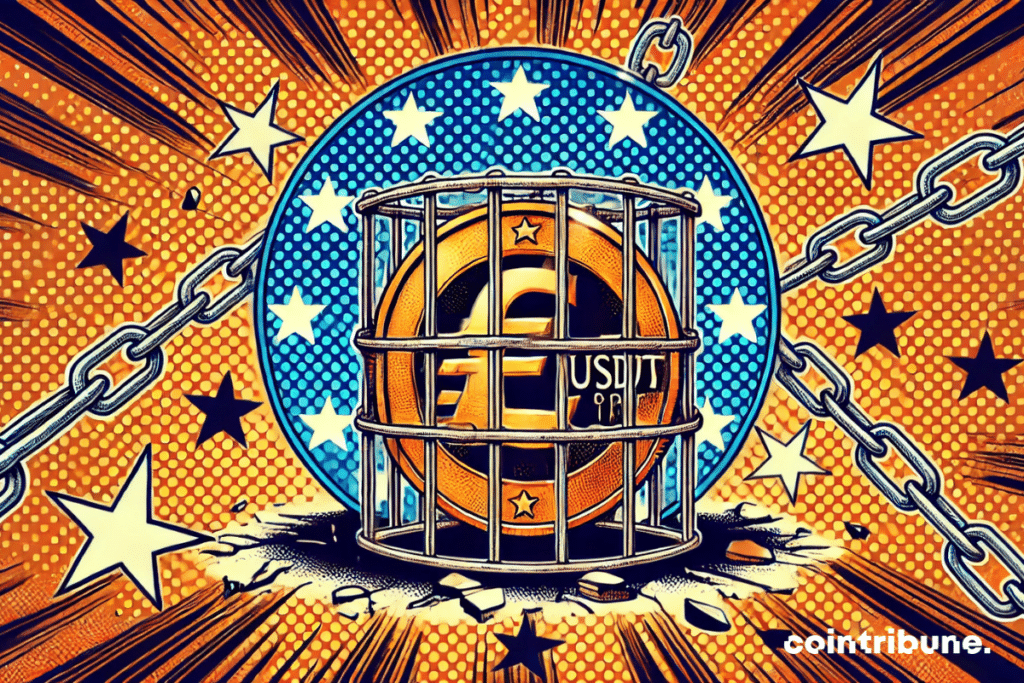Sat. December 21, 2024 ▪
5
min read ▪ by
The European Union is set to take a major step in crypto regulation with the imminent enforcement of the MiCA (Markets in Crypto-Assets) rules. This initiative, hailed by some as a step towards better transparency and an increased fight against financial abuse, however, raises serious concerns among players in the sector. Indeed, the regulation requires the withdrawal of USDT, the most used stablecoin in the world, from regulated platforms within the EU. Such a decision could disrupt the balance of European markets and call into question their attractiveness on the world stage.


The USDT Ban and Its Immediate Impacts
The rules established by the MiCA (Markets in Crypto-Assets) regulatory framework, which will come into force on December 30, 2024, impose strict obligations on stablecoin issuers. Among these requirements are obtaining an electronic money license, maintaining significant reserves and rigorous supervision of associated transactions. These constraints aim to ensure increased transparency and limit the risks of financial fraud. However, the lack of a license issued to Tether Limited has a direct and important consequence: the withdrawal of USDT, the most widely used stablecoin in the world, from regulated platforms in the European Union.
This withdrawal raises serious concerns due to the central role of USDT in crypto trading. “A large majority of crypto transactions rely on USDT, particularly for its ease of use and low costs,” said Pascal St-Jean, CEO of 3iQ Corp. The absence of this stablecoin, which serves as a cornerstone for trading pairs around the world, risks seriously disrupting the liquidity of European markets. Thus, the first signs of this disruption are already visible. For example, OKX, a platform that has already phased out USDT in Europe, has seen a shift toward fiat currencies and other stablecoins. Despite this transition, alternative solutions fail to effectively fill the void left by USDT. Fragmentation of transactions, coupled with increasing costs for investors, intensifies concerns about market fluidity and the region’s competitiveness.
A contested European strategy
While Europe takes a strict approach towards cryptocurrencies, other regions lean towards more permissive strategies. In the United States, the recent election of Donald Trump and his pro-crypto political statements have reignited investor enthusiasm. This contrast illustrates a clear divergence in geopolitical priorities. While America aims to drive innovation and adoption, Europe emphasizes control and compliance. This European choice, however, raises questions about its ability to remain competitive on the world stage.
The numbers reflect this critical dynamic. Furthermore, venture capital investments in European crypto startups fell to their lowest level in four years, reflecting investors’ distrust of a regulatory environment considered too oppressive. Additionally, MiCA, despite its ambitious goal of regulating the market, could inadvertently encourage operators to migrate to more flexible jurisdictions. This potential flight of talent and capital would further weaken an ecosystem already strained by uncertainty and lack of funding.
Beyond the immediate impacts on the markets, this debate raises a fundamental question: how can Europe reconcile regulation and innovation without compromising its competitiveness? The balance to find is delicate. While transparency and stability are essential to building trust in cryptocurrencies, imposing rules that are too rigid risks stifling technological progress and limiting the region’s attractiveness for entrepreneurs and investors. This dilemma places Europe in a risky position, the consequences of which could permanently reshape its place in the global digital ecosystem.
The abolition of USDT highlights a crucial challenge for Europe: successfully reconciling its ambition for strict regulation with the need to remain competitive in the global digital economy. The move raises major concerns, ranging from liquidity fragmentation to increased costs for investors. Added to this is the threat of an exodus of talents and businesses towards regions more favorable to innovation. While MiCA represents a decisive step towards harmonized and transparent regulation, its long-term consequences could profoundly change Europe’s role in a rapidly transforming sector. It remains to be seen whether this regulatory bet will be synonymous with stability or strategic withdrawal in the face of more flexible competitors.
Maximize your Cointribune experience with our “Read to Earn” program! For every article you read, earn points and access exclusive rewards. Sign up now and start enjoying benefits.
A graduate of Sciences Po Toulouse and holder of a blockchain consultant certification issued by Alyra, I joined the Cointribune adventure in 2019. Convinced of the potential of blockchain to transform many sectors of the economy, I took the commitment to raise awareness and inform the general public about this constantly evolving ecosystem. My goal is to enable everyone to better understand blockchain and seize the opportunities it offers. I strive every day to provide an objective analysis of current events, to decipher market trends, to relay the latest technological innovations and to put into perspective the economic and societal issues of this ongoing revolution.
DISCLAIMER
The views, thoughts and opinions expressed in this article belong solely to the author and should not be considered investment advice. Do your own research before making any investment decisions.

